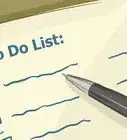This article was co-authored by Steve Bergeron. Steve Bergeron is a Personal Trainer, Strength Coach, and the Co-Owner of AMP Fitness in Boston, Massachusetts. With over a decade of experience, Steve specializes in educating, guiding, and empowering his clients to develop healthy habits and reach their individual fitness goals. He holds a BS in Exercise Physiology and is an NSCA Certified Strength and Conditioning Coach (CSCS), ASCM Health and Fitness Specialist (HFS), Strong First Kettlebell Coach (SFG), and Certified Functional Movement Screen Specialist (FMS). AMP Fitness’ mission is to create a community that is inclusive and gives people the tools and support they need to succeed.
There are 7 references cited in this article, which can be found at the bottom of the page.
wikiHow marks an article as reader-approved once it receives enough positive feedback. In this case, several readers have written to tell us that this article was helpful to them, earning it our reader-approved status.
This article has been viewed 2,717,797 times.
Do you want to get the most out of those 35 minutes on the treadmill, or any kind of cardio exercise? You can maximize the benefits of cardiovascular activity when you exercise in the zone of your target heart rate (THR). All you need to get started is a calculator and a pulse. There are quick and easy ways to get good estimates of your target heart rate zones, but if you want to get the most reliable measurements possible without any fancy equipment, follow this formula.
Steps
Calculating Your THR with the Karvonen Method
-
1Calculate your maximum heart rate (HRmax). Your maximum heart rate is the fastest your heart can go in beats per minute (bpm). To estimate this, multiply your age by 0.7, then subtract the result from 207.[1] This is well beyond what most people reach (or should reach) during exercise, so don't rely on a heart rate monitor for this step.
- For example, if you are 39 years old, estimate 207 - (0.7)(39) = 207 - 28 = ~180 bpm HRmax.
- There are several similar formulas in use, so you may hear slightly different estimates from your doctor or exercise coach. Avoid estimates based on the outdated "220 - your age" formula.[2] You can get a good, quick, and easy estimate with the 220-age formula. Just remember that it is accurate to only +/- 2 or 3 beats per minute.
-
2Check your resting heart rate (RHR). The Karvonen method takes into account your resting heart rate, which varies from person to person, and therefore provides more reliable calculations for each person. Before getting out of bed in the morning, check your pulse by placing the tips of your index and middle finger against your inner wrist, or on your throat to either side of your windpipe.[3] Watch a clock with a second hand and count the number of heart beats in 30 seconds, starting with "zero" on the first heartbeat.[4] Multiply the count by 2 to get your resting heart rate in beats per minute.
- For greater accuracy, find the average from three different mornings. For example, if you measure 62, 65, and 63 bpm, the average is (62 + 65 + 63) / 3, or about 63 bpm RHR.
- Smoking, caffeine, stress, hot weather, hormone fluctuations, and many medications all affect your heart rate. Do your best to minimize these factors before measuring your RHR.
Advertisement -
3Calculate your Heart Rate Reserve (HRR). This is the difference between your heart rate at rest and your heart rate at maximum effort. We call it your "heart rate reserve:" the extra intensity your heart has available for when you need it.
- To get your HRR, use the equation HRMax - RHR = HRR.
- For example, if your maximum heart rate (HRmax) is 180 bpm and your resting heart rate (RHR) is 63 bpm, then your heart rate reserve is 180 - 63 = 117 bpm.
-
4Calculate your Target Minimum Heart Rate (Target HRMin). Multiply your HRR by 0.5. It is not healthy or beneficial to use up your entire heart rate reserve during normal exercise. Instead, you can aim to use a percentage of your reserve based on how strenuously you would like to exercise. Multiply your heart rate reserve by 0.5 to find the minimum increase needed for moderate exercise.
- If your heart rate reserve is 117 bpm, using half of this reserve would mean increasing your heart rate by (117) x (0.5) = 58.5 bpm.
- Add the result to your resting heart rate for the target minimum heart rate. The answer is the low end of your target heart rate. This is a good target for people who have just started to exercise regularly, or who are recovering from an injury.
- Using the numbers above, a resting heart rate of 63 bpm + an increase of 58.5 bpm = 121.5 bpm minimum Target Heart Rate.
-
5Calculate your moderate Target Heart Rate (Target HRMod). Replace 0.5 with a higher decimal to calculate a higher target heart rate. If you are just starting an exercise program, you may want to gradually increase your target as your fitness improves, up to about 0.7 for the high end of moderate exercise. If you are an athlete choosing a target heart rate for vigorous exercise, you may want to start at 0.7 or higher.
-
6Calculate your Intense Target Heart Rate (Target HRIntense). Extreme-intensity, anaerobic exercise might use 0.85 of your reserve.To find this number, use the equation: (HRR x 0.85) + RHR = HRIntense.
Determining Exercise Intensity by Using the THR
-
1Check your heart rate during a workout session. In order to do this, stop exercising and immediately check your pulse by counting your heartbeats for 10 seconds. Resume exercise and multiply the number of beats per 10 seconds (your pulse) by 6 and you'll have your heart rate (beats per 60 seconds, that is beats per minute).
- A more accurate way of doing this is by using a heart monitor to get heart rate readings during a workout session.[5]
-
2Base the intensity of your physical activity on your THR. You can determine whether the intensity of your physical activity is low, moderate or high by measuring the workout heart rate (bpm) against your THR. If your heart rate falls into the middle of your THR range or corresponds to your average THR, that means you're exercising at moderate intensity (roughly 50 to 70% of your HRmax). If it verges toward the upper limit, you're exercising at high intensity (70 to 85% of your HRmax).
- If you have just started working out, aim for a low to moderate intensity. You can increase it as your body gets used to exercising.[6]
- Your heart rate should also be in the lower range of your THR when you are warming up or cooling down.
- As you exercise, make sure your heart rate never goes beyond your maximum heart rate.
-
3Judge how your body responds. This formula will give a good estimate for most people, but it's not foolproof. Pay attention to how your body responds when you reach the target heart rate you calculated. Adjust your target heart rate if necessary based on your observations:[7] [8]
- Moderate exercise (the lower end of your target) should cause mild to moderate sweating and faster breathing. You may have mild muscle aches for a day or two if you are not used to exercise.
- Vigorous exercise (the upper end) causes hard breathing — you must pause for breath after a few words.
- Stop exercising and seek medical help if you experience breathing problems, chest pain, severe muscle or joint pain, dizziness, extreme sweating, or extreme fatigue. Lower your target heart rate in future.
Expert Q&A
-
QuestionIs target heart rate a good metric to use for your workouts?
 Steve BergeronSteve Bergeron is a Personal Trainer, Strength Coach, and the Co-Owner of AMP Fitness in Boston, Massachusetts. With over a decade of experience, Steve specializes in educating, guiding, and empowering his clients to develop healthy habits and reach their individual fitness goals. He holds a BS in Exercise Physiology and is an NSCA Certified Strength and Conditioning Coach (CSCS), ASCM Health and Fitness Specialist (HFS), Strong First Kettlebell Coach (SFG), and Certified Functional Movement Screen Specialist (FMS). AMP Fitness’ mission is to create a community that is inclusive and gives people the tools and support they need to succeed.
Steve BergeronSteve Bergeron is a Personal Trainer, Strength Coach, and the Co-Owner of AMP Fitness in Boston, Massachusetts. With over a decade of experience, Steve specializes in educating, guiding, and empowering his clients to develop healthy habits and reach their individual fitness goals. He holds a BS in Exercise Physiology and is an NSCA Certified Strength and Conditioning Coach (CSCS), ASCM Health and Fitness Specialist (HFS), Strong First Kettlebell Coach (SFG), and Certified Functional Movement Screen Specialist (FMS). AMP Fitness’ mission is to create a community that is inclusive and gives people the tools and support they need to succeed.
Personal Trainer & Strength Coach Target heart rate can be deceiving because it doesn't necessarily correspond with your current health and fitness level or your experience. It's really a generalization. A better metric would be just how you feel while you're working out. We generally recommend that most people train at a level between six and seven out of ten in terms of intensity. That will help you see progress without getting overly fatigued.
Target heart rate can be deceiving because it doesn't necessarily correspond with your current health and fitness level or your experience. It's really a generalization. A better metric would be just how you feel while you're working out. We generally recommend that most people train at a level between six and seven out of ten in terms of intensity. That will help you see progress without getting overly fatigued. -
QuestionWhat are the stages of an effective exercise routine?
 Michele DolanMichele Dolan is a BCRPA certified Personal Trainer in British Columbia. She has been a personal trainer and fitness instructor since 2002.
Michele DolanMichele Dolan is a BCRPA certified Personal Trainer in British Columbia. She has been a personal trainer and fitness instructor since 2002.
Certified Fitness Trainer Of course the stages vary depending on the goal of the workout, but in the most general terms, a cardio workout begins with a 5 to 10 minute warm up where the heart rate becomes elevated to HRMin, then exercise sustains the heart rate between HRMin target and HRMax target. The length of this sustained period depends on your goals but 20 minutes would be a reasonable length of time. Then a cool down period would follow where one gradually lowers the heart rate to below the HRMin target. This might take another 5 to 10 minutes. Stretching would be a good follow up at this point.
Of course the stages vary depending on the goal of the workout, but in the most general terms, a cardio workout begins with a 5 to 10 minute warm up where the heart rate becomes elevated to HRMin, then exercise sustains the heart rate between HRMin target and HRMax target. The length of this sustained period depends on your goals but 20 minutes would be a reasonable length of time. Then a cool down period would follow where one gradually lowers the heart rate to below the HRMin target. This might take another 5 to 10 minutes. Stretching would be a good follow up at this point. -
QuestionWhat is the formula to figure out your target heart rate?
 Michele DolanMichele Dolan is a BCRPA certified Personal Trainer in British Columbia. She has been a personal trainer and fitness instructor since 2002.
Michele DolanMichele Dolan is a BCRPA certified Personal Trainer in British Columbia. She has been a personal trainer and fitness instructor since 2002.
Certified Fitness Trainer Let's say that you are trying to burn fat. You want to keep your heart rate above about 65% of its maximum. A good quick way to get an approximate value is this formula: 220 - (Your Age) x 0.65 = 65% of your heart rate maximum.
Let's say that you are trying to burn fat. You want to keep your heart rate above about 65% of its maximum. A good quick way to get an approximate value is this formula: 220 - (Your Age) x 0.65 = 65% of your heart rate maximum.
Warnings
- The target heart rate is only an estimate! If you get exhausted too early or too often, it means you are working out too hard and should ease off.⧼thumbs_response⧽
- Visit a doctor if you are at risk of heart problems. If you have a heart condition or take medication that affects your heart or blood pressure, do not try to calculate your own THR (target heart rate). Ask a doctor to examine you and help you form a safe exercise plan. It's also a good idea to involve your doctor in any new exercise plan if you are overweight, over 40 years old, or have not exercised in a long time.[9]⧼thumbs_response⧽
References
- ↑ http://europepmc.org/abstract/med/17468581
- ↑ http://www.runnersworld.com/ask-the-sports-doc/what-is-my-maximum-heart-rate
- ↑ https://www.betterhealth.vic.gov.au/health/healthyliving/exercise-intensity
- ↑ http://www.cdc.gov/physicalactivity/basics/measuring/heartrate.htm
- ↑ https://www.betterhealth.vic.gov.au/health/healthyliving/exercise-intensity
- ↑ http://www.heart.org/HEARTORG/HealthyLiving/PhysicalActivity/FitnessBasics/Target-Heart-Rates_UCM_434341_Article.jsp#.Vyo7BKNcSko
- ↑ https://www.betterhealth.vic.gov.au/health/healthyliving/exercise-intensity
- ↑ http://www.nhs.uk/chq/Pages/2419.aspx?CategoryID=52&
- ↑ https://www.betterhealth.vic.gov.au/health/healthyliving/exercise-intensity
About This Article
To calculate your target heart rate, first estimate your maximum heart rate by multiplying your age by 0.7 and then subtracting that number from 207. Next, determine your resting heart rate by feeling your pulse after you wake up in the morning and counting the number of beats in 1 minute. Once you've found both of those, subtract your resting heart rate from your maximum heart rate. Finally, multiply that number by 0.5-0.85 to find your target heart rate, depending on how moderate or intense you want your target heart rate to be. To learn how to incorporate your target heart rate into your exercise routine, scroll down!
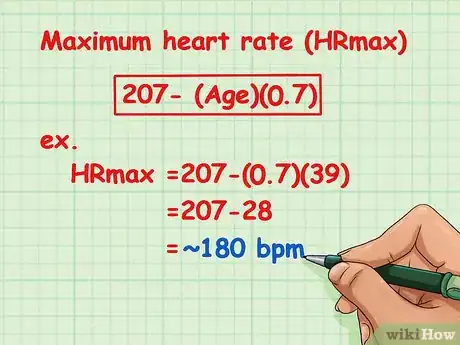
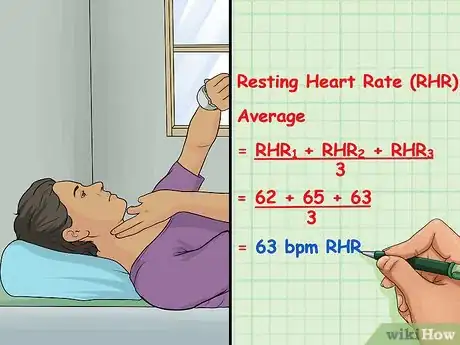
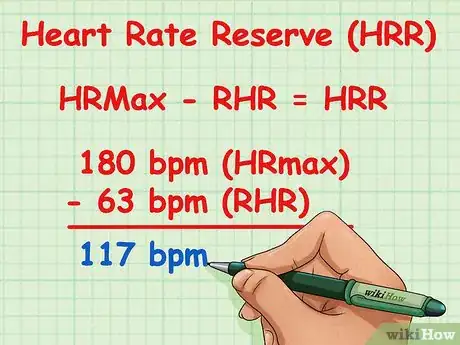
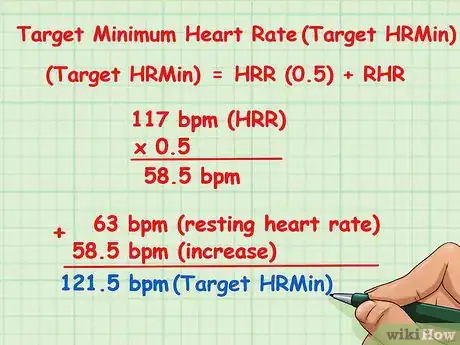



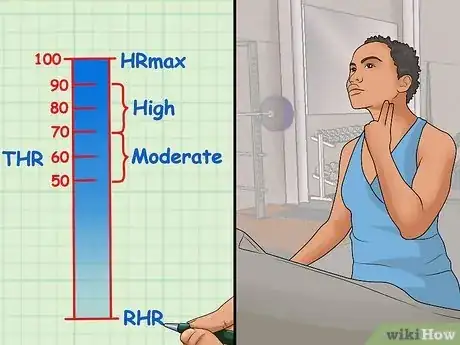

-Step-14-Version-3.webp)





















-Step-14-Version-3.webp)

